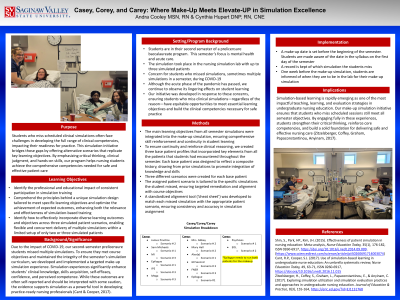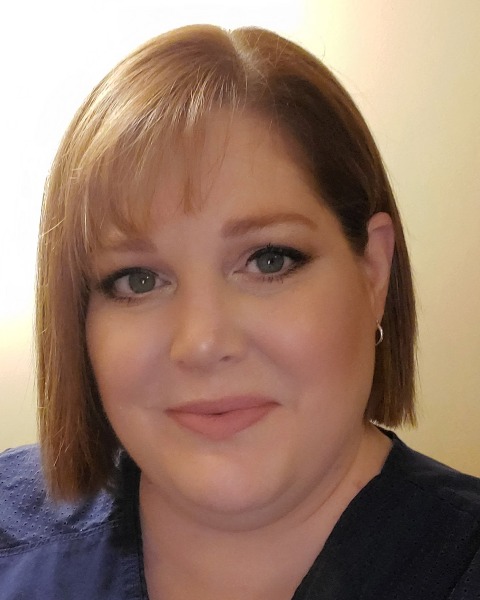Education
(49) Casey, Corey, & Carey: Where Make-Up Meets Elevate-Up in Simulation Excellence
Thursday, June 19, 2025
5:00 PM - 6:30 PM MST
Location: Exhibit Hall


Andra Cooley, MSN RN
Nursing Simulation Educator
Saginaw Valley State University
Essexville, Michigan, United States
Cynthia Hupert, DNP, RN, CNE
Cynthia Hupert
Saginaw Valley State University
Grand Blanc, Michigan, United States
Lead Author(s)
Co-Author(s)
Abstract: A significant challenge in nursing education is maintaining equity and integrity when students miss scheduled simulation experiences. Traditional make-up sessions often involve repeating the same scenario, potentially compromising simulation fidelity and learning effectiveness. This gap in educational practice necessitates an innovative approach to achieve equivalent learning outcomes while protecting scenario integrity.
Guided by Kolb's experiential learning theory, we developed an alternative simulation experience for second-semester prelicensure nursing students in a mental health/medical-surgical course. The theoretical framework informs the design through concrete experience with standardized patients, reflective observation during debriefing, and active experimentation of clinical skills.
Our solution features three standardized patient encounters with scenario variations, each aligned with original simulation objectives while maintaining core competencies in assessment, clinical reasoning, and therapeutic communication. Students attend a dedicated make-up session where they interact with standardized patients trained specifically for these alternative scenarios. Individual debriefing sessions with both the standardized patient and facilitator utilize the PEARLS framework to reinforce learning objectives.
This project advances simulation science by providing a framework for creating equivalent alternative experiences that maintain scenario integrity while ensuring consistent learning outcomes.
Please include a short summary of your presentation that highlights why an attendee would want to view your poster.: This presentation demonstrates how to integrate multiple simulation learning objectives for second semester prelicensure nursing students into one make-up simulation that includes various scenarios. This simulation takes the learning objectives from 12 simulations and integrates them into three patients with three scenarios for each patient. Utilizing this design has allowed for a seamless way to add new learning objectives and remove old ones.
Guided by Kolb's experiential learning theory, we developed an alternative simulation experience for second-semester prelicensure nursing students in a mental health/medical-surgical course. The theoretical framework informs the design through concrete experience with standardized patients, reflective observation during debriefing, and active experimentation of clinical skills.
Our solution features three standardized patient encounters with scenario variations, each aligned with original simulation objectives while maintaining core competencies in assessment, clinical reasoning, and therapeutic communication. Students attend a dedicated make-up session where they interact with standardized patients trained specifically for these alternative scenarios. Individual debriefing sessions with both the standardized patient and facilitator utilize the PEARLS framework to reinforce learning objectives.
This project advances simulation science by providing a framework for creating equivalent alternative experiences that maintain scenario integrity while ensuring consistent learning outcomes.
Please include a short summary of your presentation that highlights why an attendee would want to view your poster.: This presentation demonstrates how to integrate multiple simulation learning objectives for second semester prelicensure nursing students into one make-up simulation that includes various scenarios. This simulation takes the learning objectives from 12 simulations and integrates them into three patients with three scenarios for each patient. Utilizing this design has allowed for a seamless way to add new learning objectives and remove old ones.
Learning Objectives:
- Demonstrates therapeutic communication with patients and families while incorporating cultural sensitivity and addressing psychosocial needs.
- Applies effective clinical judgements and skills to safely administer medications
- Perform priority nursing actions based on assessment and clinical data
- Demonstrate understanding and clarity when communicating with the provider
